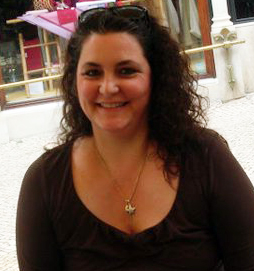Bill Howze: You’ve woven together several evocative themes in your essay “Breath“: memory, family gatherings, cold weather, disease—tuberculosis in particular, its symptoms, diagnosis, treatment, means of contagion, and cultural manifestations, and porches—porches appear more frequently than any other setting. How did these themes present themselves to you?
Rebecca Spears: “Breath” didn’t begin intentionally as an essay, nor as a whole story that I could tell in a linear way. I didn’t know what this story was or why the image of my grandfather on the porch at the VA hospital was so important to me. Yet throughout my life, the image would slip into focus, from time to time, in my waking memory.
The process of making “Breath” began with that fragment and other memory fragments that I jotted in notebooks and put into computer files, images that, for a long time, I didn’t know were connected or what they really meant to me—so I suppose the notion of themes wasn’t apparent until much later in the process.
I’d been writing poetry for some time, and I often work with images first, writing down an image that intrigues me, trying to get all its details sketched. I may not do anything with that image ever, or it may sit in my notebook for a while before I use it.
Anyhow, once I realized I was collecting images of cold winters, of the pleasure of the cold, of having one’s breath taken away—both literally, as in disease, and figuratively, as in a stunning winter scene, I was able to start recalling other images of breath and air. That’s when the larger theme of breath began to take shape.
From there I veered toward the way that cold weather can bring people together in a huddle, in closed spaces. And as I continued to work with these images, I thought about “cabin fever,” how the air gets stale, and less oxygenated, how when you step out into a cold landscape, there’s a momentary feel of the air turning crystal and filling your lungs with good, fresh, oxygen.
Then I began collecting images of the coming warmth in spring, and how that meant gathering with friends and family outdoors on our porches. Some of my best memories are of relaxing on porches, sharing the time and space with friends and family. Porches, I realized, are safe places, because they are connected to our shelter, and yet from a porch, we can look out at the world.
BH: You introduce the term “exsanguination,” the way “blood retreats from the vulnerable parts of the body, most noticeably the nose,” to describe “the air on cold days and the experience of inhaling it.” In addition to the sensation, the term also describes a movement that recurs in your essay in situations of vulnerability: the family moves away from the ice- rimed windows, toward the oven and the kitchen table; you retreat from contact with the “snot-boys” possibly carried by your students; waiting for the results of a TB test, your anxiety manifests itself as a tightness in your chest, a sort of nervous exsanguination. What other responses to vulnerabilities might haunt this piece?
RS: I first experienced winters that could kill a person when I moved to the Midwest with my husband, so that he could finish an undergraduate degree and then attend medical school. We moved from Texas with one child, and along the way, we had two more children. Over the decade that we lived in Illinois and Iowa, I realized how vulnerable a family is to the vagaries of fortune and well-being.
One vivid memory I have is of taking our kids to the park on a wintry day. The hills were overlaid with snow, and we sledded for an hour or two, having a fun romp. Within a week, both kids had developed pneumonia, an illness that I’d never thought much about. At the time, I believed that our afternoon in the park might have been to blame. Luckily, with antibiotics, the kids recovered. Yet my son, who was asthmatic, took longer to get well, and the cold continued to aggravate his asthma terribly all that winter. (By the way, I didn’t realize until much later that our sledding hadn’t caused the pneumonia. It is a bacterial infection, and that is why it can be treated with antibiotics).
The second year in the Midwest, everyone in the family (except me) came down with a terrible flu, and I played nurse to all of them for a couple of weeks. At one point, I thought my husband was going to die, really. This was possibly the first time I realized how precious life is and how it might be taken away in an instant. We are indeed vulnerable creatures. So I think this essay tries to put into perspective how germs (or “the snot-boys”) can change our lives in monumental ways.
And the epic cold that I first experienced in the Midwest could and did kill people every year we lived there; people would get stranded in blizzards and perish; people would fall on icy sidewalks and break their bones. The power could go out and someone might freeze to death in his own home. So perhaps the larger vulnerability that haunts this essay is our fragility, our mortality.
BH: How did you decide the order of the eight sections of this essay? Each section begins with an engaging sentence, and there are only a couple of relatively direct transitions from one section to the next. An editor might observe that the essay could have begun with any of these five sections—your grandfather waving from a screened porch; Claire’s reference to the “snot-boys”; your mother’s story of your grandfather with TB living at your house; your teen years and swimming; or even your recent experience of having a small cabin built on wooded land.
R.S: In the end, I sought to make this piece image-driven, because the process of writing itself was so image-driven. In addition, I wanted the reader to experience the discovery of the connections among the images as I discovered them myself. The essay tries to mimic my own wonderment, as I uncovered the connections.
Of course, I took a risk in shaping the essay in this way. I realized that readers could get easily bored by it and decide not to read; or that the reader might be baffled even by the end of the essay. Thus, for many of the sections, I tried to tease out the strongest part of each scene and begin close to the highest point of tension to keep the reader’s interest, and I hope, to make it easier for readers to find the relationships among the scenes. Fiction writers and screenwriters are often advised to go into a scene “late and leave early.” I kept that in mind while crafting each section of the essay. At the same time, I was also weaving in the larger story of tuberculosis and how it literally takes away the breath.
The last thing I want to address is the seeming lack of transition in the essay. I decided to use juxtapositioning as a way to stitch the pieces together. Poets often juxtapose phrases and images in a poem in ways that let the reader make his or her own connections in the interstices. In my poetry, this is a habit I’ve had a lot of practice with. I wanted to try that with the essay. And I might add that, as a teacher of writing, I have to work so often with my students on logical progression in academic writing that it exhausts me. As a creative writer, then, I want to let loose and get away from the strictly linear form.
William Howze is a humanities program consultant and video producer for museums and cultural organizations. He received his BA and MPhil degrees from Yale University, specializing in American Studies, Art History and Museum work. For his PhD from the University of Texas, he documented the influence of genre painting and Western art on the films of John Ford. Recently he has selected works of art and written essays to guide viewing for Medical Humanities, An Introduction, a textbook to be published by the Cambridge University Press. In addition to producing several dozen short videos for art museum exhibitions, he edited and co-produced The Strange Demise of Jim Crow, a film that documents the struggle to integrate public facilities in Houston that has been broadcast on local and national public television. He has taught as adjunct professor, visiting artist, or faculty advisor for the following institutions: University of Houston College of Education, Art Department, College of Architecture, and Distance Education Program; Texas A&M University Visualization Laboratory; Houston Baptist University MLA Program; University of Houston Clear Lake History and Humanities Program; and Texas Christian University Department of Radio‑TV‑Film. He created the department of Special Programs at the Amon Carter Museum in Fort Worth and initiated the museum’s program of public lectures, workshops, festivals, film series, and continuing education college courses, with funding from the NEA, NEH, TCA, TCH and other sources.





